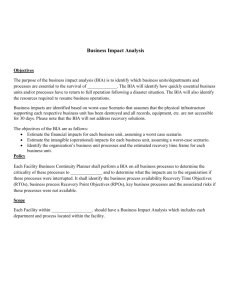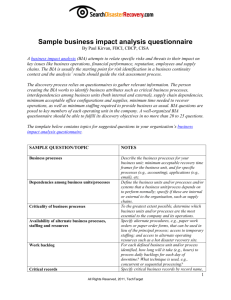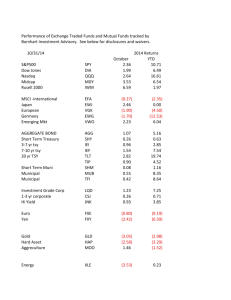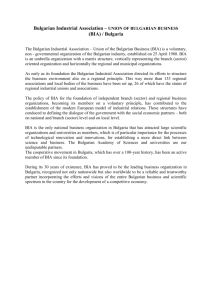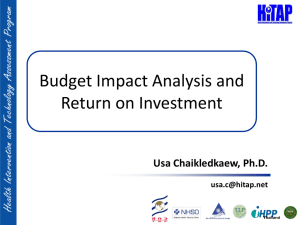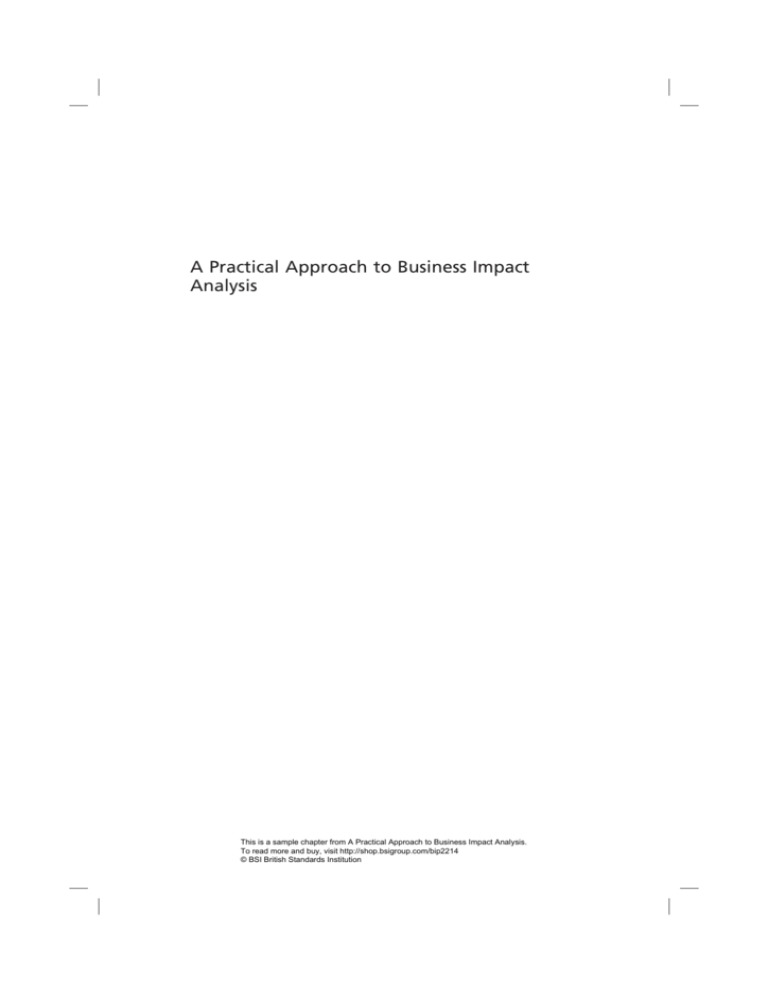
A Practical Approach to Business Impact
Analysis
This is a sample chapter from A Practical Approach to Business Impact Analysis.
To read more and buy, visit http://shop.bsigroup.com/bip2214
© BSI British Standards Institution
This is a sample chapter from A Practical Approach to Business Impact Analysis.
To read more and buy, visit http://shop.bsigroup.com/bip2214
© BSI British Standards Institution
A Practical Approach to Business
Impact Analysis
Understanding the Organization through
Business Continuity Management
Ian Charters
This is a sample chapter from A Practical Approach to Business Impact Analysis.
To read more and buy, visit http://shop.bsigroup.com/bip2214
© BSI British Standards Institution
First published in the UK in 2011 by BSI, 389 Chiswick High Road, London W4 4AL
© British Standards Institution 2011
All rights reserved. Except as permitted under the Copyright, Designs and Patents
Act 1988, no part of this publication may be reproduced, stored in a retrieval
system or transmitted in any form or by any means – electronic, photocopying,
recording or otherwise – without prior permission in writing from the publisher.
Whilst every care has been taken in developing and compiling this publication, BSI
accepts no liability for any loss or damage caused, arising directly or indirectly in
connection with reliance on its contents except to the extent that such liability
may not be excluded in law.
BSI has made every reasonable effort to locate, contact and acknowledge
copyright owners of material included in this book. Anyone who believes that they
have a claim of copyright in any of the content of this book should contact BSI at
the above address.
BSI has no responsibility for the persistence or accuracy of URLs for external or
third-party internet websites referred to in this book, and does not guarantee that
any content on such websites is, or will remain, accurate or appropriate.
The right of Ian Charters to be identified as the author of this Work has been
asserted by him in accordance with sections 77 and 78 of the Copyright, Designs
and Patents Act 1988.
Typeset in Great Britain by Letterpart Limited - letterpart.com
Printed in Great Britain by Berforts Group, www.berforts.co.uk
British Library Cataloguing in Publication Data
A catalogue record for this book is available from the British Library
ISBN 978-0-580-73101-3
This is a sample chapter from A Practical Approach to Business Impact Analysis.
To read more and buy, visit http://shop.bsigroup.com/bip2214
© BSI British Standards Institution
Contents
Acknowledgements
Foreword
Preface
About the author
Introduction
1
What is Business Impact Analysis?
A definition
Why is a BIA so important?
What are the prerequisites?
BIA scope
2
Understanding the BIA
Time and impact
Terminology
Resources
Interdependencies
BIA in different sectors
Alternative approaches
3
Planning the BIA – Project or Process?
BIA as a project
BIA as a process
4
Strategic BIA
The organization’s strategic review
Using a BIA to set the scope of the BCM programme
Preparing for the Strategic BIA
Conducting a Strategic BIA
Strategic BIA report
5
Tactical BIA
Setting the scope
Initiating a Tactical BIA
Data collection – choosing the participants
Data collection – the data
Data collection – methods
Completing the process
A Practical Approach to Business Impact Analysis
This is a sample chapter from A Practical Approach to Business Impact Analysis.
To read more and buy, visit http://shop.bsigroup.com/bip2214
© BSI British Standards Institution
vii
viii
ix
xi
xiii
1
1
1
3
4
5
5
16
31
34
39
44
51
51
58
61
61
61
62
64
66
67
67
67
69
69
71
79
v
6
Operational BIA
Activity urgency
Quantifying resource requirements
Collection of operational data
Analysing the Operational BIA data
Reporting the Operational BIA data
7
Outcomes from the BIA programme
89
89
90
96
101
102
Threat assessment
BC recovery strategies
Writing the plan
BCM awareness
Improving the business
Personal development
105
105
106
109
111
112
112
8
115
Reflection
Appendix 1
Consolidated Tactical and Operational BIA form
Appendix 2
Bibliography
vi
117
117
121
121
A Practical Approach to Business Impact Analysis
This is a sample chapter from A Practical Approach to Business Impact Analysis.
To read more and buy, visit http://shop.bsigroup.com/bip2214
© BSI British Standards Institution
Introduction
The aim of this book
For a topic as important to a discipline as BIA is to BCM, there is
remarkably little written on the subject or available on the internet.
There are templates available, both for free and for payment, but few
explorations of the wider issues that are needed to make effective use of
those templates even within the sector for which they were designed.
This is because it is difficult, in a few pages, to describe the process of
BIA and show its applicability in all sectors. In addition, the BIA method
used by external consultants to initiate a BCM programme may appear to
bear little relation to the BIA process embedded in the processes of more
BCM-mature organizations.
This book is not going to present the reader with a ‘one size fits all’
template for undertaking a BIA in every sector. Blindly following a
template is unlikely to result in a meaningful result. Instead readers are
invited to think through the guidance offered, consider the purpose of
the data they will collect and devise their own BIA method which fits the
current and future needs of their business.
About this book
The term ‘Business Impact Analysis’ has been applied to a wide variety of
different methods over the years but a consensus has emerged in the last
few years following the publication of BS 25999-1, Business continuity
management — Code of practice, BS 25999-2, Business continuity
management — Specification and, more recently, ASIS/BSI (BCM.01:2010).
An international standard is yet to be published but ISO/DIS 22301
suggests that the approach in the earlier standards will be adopted. The
methods that support the implementation of these standards are
described in the Business Continuity Institute’s Good Practice Guidelines
2010 (GPG 2010), which is regularly updated to reflect current practice.
The scope of this book covers the topic ‘Business Impact Analysis’ that is
described (with minor variations) in these standards and guidance. In
BS 25999 and the GPG 2010 the ‘Continuity Requirements Analysis’ is
described as a separate step but, because this collection of resource
requirements is usually undertaken at the same time as a BIA, this has
been included in the scope of this text.
A Practical Approach to Business Impact Analysis
This is a sample chapter from A Practical Approach to Business Impact Analysis.
To read more and buy, visit http://shop.bsigroup.com/bip2214
© BSI British Standards Institution
xiii
Introduction
It has been assumed that there is top management support for
undertaking a BIA; if not, then efforts need to be made to gain this
support first, a topic not covered here.
The first chapter presents a definition of BIA, explains its importance in
the BCM Programme and sets the context in which it is performed.
The second chapter examines the concepts and terminology of the BIA.
The reader may prefer to skip this chapter, referring back to it from later
chapters when further explanation is required.
The third chapter describes two approaches to undertaking a BIA. A
project approach is usually adopted for an initial BIA. Once a BCM
programme is established, the BIA can become a process, split into a
number of linked activities that are embedded in the organization’s
management procedures.
The next three chapters discuss how to conduct the BIA as part of a
programme using the ‘Strategic, Tactical and Operational’ model. Those
undertaking a first BIA are likely to include elements of all these in
coming to an initial understanding of the organization.
The final chapter shows how the results from the BIA project or
programme provide the information on which the appropriate BCM
strategies can be selected and effective recovery plans developed.
Having said that, no universal template can be provided; Appendix 1
contains a cross reference to the various topics in the text from which
readers can, if they wish, create a template for use within their
organization.
Throughout this book two icons are used to help you find what you
need:
Real-life examples describing tried and tested approaches
Key points
xiv
A Practical Approach to Business Impact Analysis
This is a sample chapter from A Practical Approach to Business Impact Analysis.
To read more and buy, visit http://shop.bsigroup.com/bip2214
© BSI British Standards Institution
1
What is Business Impact Analysis?
A definition
The BCI’s Glossary, BS 25999 and ISO/DIS 22301 all define a BIA as ‘the
process of analysing business functions and the effect that a business
disruption might have upon them’; the ASIS/BSI BCM.01 2010 definition is
very similar.
To understand the effect of a disruption a BIA needs to ask:
•
•
•
•
•
What are the key business/service objectives of the organization?
What products and services are required to meet these objectives of
the organization? (Deliverables)
How are the objectives going to be achieved? (Activities)
Who and what needs to be involved (both internally and externally)
to achieve the objectives? (Resources)
(And most crucially) When do these objectives need to be achieved?
(Time)
These questions are standard business analysis queries but only in the BIA
does the last question – relating to time – play such a key role.
A BIA looks at each product, service, process and activity within the
organization, understands its significance to the organization and
determines the impacts over time that would result if it were to be
disrupted.
It also documents the interdependencies of the activities within a
business and with suppliers of goods and services. It is necessary to
understand this complexity to make estimates of the impacts over time of
a disruption to back office and corporate activities.
Once the impacts have been determined, the maximum tolerable period
of disruption (MTPD) can then be estimated by asking how long it will be
before the continuing failure to carry out the activity will create
intolerable impacts.
Why is a BIA so important?
It is necessary to undertake a BIA to understand how quickly the
organization needs to respond when a disruption to normal business
A Practical Approach to Business Impact Analysis
This is a sample chapter from A Practical Approach to Business Impact Analysis.
To read more and buy, visit http://shop.bsigroup.com/bip2214
© BSI British Standards Institution
1
1
What is Business Impact Analysis?
occurs. It becomes a statement of requirements for the recovery strategy
following a disruption. By knowing how quickly the delivery of the
various products and services needs to be restored, we can work out how
quickly the various activities within and outside the business need to be
recovered to enable that to happen.
If these recovery requirements are guessed at, without a BIA process, we
could set recovery objectives but when an incident occurs these might be
either an:
•
•
underestimate – leading to the organization suffering severe or
terminal damage as it could not meet the time or scale of recovery
demanded by its customers even though there was a plan; or an
overestimate – and the organization would continually be spending
sums of money on recovery capabilities that were not required,
making it uncompetitive or inefficient.
Sometimes there is a limit to how long customers will wait:
Following a fire, a manufacturing company rebuilt its plant
with the insurance payout, but within six months it had closed
because its customers had taken their custom elsewhere and,
on resumption of production, too few were won back from
their competitors to make the new plant profitable.
Sometimes the need for a speedy recovery is overestimated: A
government department was paying a supplier to provide a
4-hour on-site response to multiple locations. To achieve this,
the supplier had several mobile facilities in various places
enabling it to fulfil this contractual requirement. However, for
various reasons, an incident went unresolved for 36 hours but
there were no serious repercussions of this delay. The contract
was renegotiated to 36 hours, which required just one mobile
unit, thus saving a substantial sum.
So the BIA will enable the organization to select an appropriate
approach to, and a detailed strategy for, business resumption after a
disruption. In times of financial pressure and in the public sector it is
particularly important to demonstrate this close match between
requirements and spending.
Once the strategy is selected, the BIA can even assist us in working out
how long an ‘escalating’ incident can be left until the plan is invoked.
This decision of when to act (for example, to move to an alternative
location) is particularly difficult in situations where the problem is
temporary, such as a power failure or denial of access.
2
A Practical Approach to Business Impact Analysis
This is a sample chapter from A Practical Approach to Business Impact Analysis.
To read more and buy, visit http://shop.bsigroup.com/bip2214
© BSI British Standards Institution
What are the prerequisites?
The BIA also provides an opportunity to make managers more aware of
the need for BCM and how it affects their role.
The BIA is conventionally used to determine the current recovery
requirements of an organization. It can also be used to consider the
impact of disruption under other assumptions. So an organization
considering a major change, such as relocation or reorganization, could
use the BIA to identify which configurations, from a number of
possibilities, provide the required resilience.
What are the prerequisites?
It should be obvious that it is necessary to obtain the full support of the
organization’s senior management before starting a BIA. Attempts to
speak to managers may be rebuffed unless this support is forthcoming. It
also needs to be ‘sold’ to managers as being of interest to them as
individuals and an explanatory note in advance of a meeting (described
later – see Chapter 5) should address both requirements.
It may be premature to launch into a BIA before there is a semblance of
a BCM programme in place. A BIA conducted by an external consultancy
may fail to be followed up if there is no identified individual within the
organization to learn from the BIA and implement the solutions required
by its findings.
Training of people to plan and undertake a BIA – whether
classroom-based or self-study – on BCM and particularly on the BIA
method, is essential to ensure that the process is effective. Even if an
external specialist is being employed, it will be useful for in-house
personnel to receive training so they can assist the specialist to
understand their organization and take the learning forward when the
external specialist leaves.
Undertaking a BCM exercise with the senior management in advance of
the formal BIA may be useful. Exploring their reaction to a disruption will
achieve:
•
•
•
an appreciation of the need for a BCM programme by the senior
management – so buy-in for the BIA will be enhanced;
an initial understanding of the business – especially the products,
services and the major stakeholders as perceived by management;
a preliminary acceptance of the context and scope of the BIA, if this
has not yet been decided.
In an ideal BCM programme, a BIA should be undertaken using the scope
(or a subset of the scope) as set out in the BCM Policy. However, if a
A Practical Approach to Business Impact Analysis
This is a sample chapter from A Practical Approach to Business Impact Analysis.
To read more and buy, visit http://shop.bsigroup.com/bip2214
© BSI British Standards Institution
3
1
What is Business Impact Analysis?
policy is not yet agreed, a BIA may be a valuable tool to gain a sufficient
understanding of the organization to enable the scope of a BCM Policy
to be drafted.
BIA scope
The scope of a BIA should be defined in terms of products or services
since, at the strategic level, it is primarily about customer response. The
term ‘product and service’ is shorthand for a wide variety of options
which can include:
•
•
•
a group of products or services which have similar characteristics;
a single product (or group) delivered to a single customer;
products supplied to a specific geographical area (where one possible
strategy is to provide the product from another area).
When using a wide geographical scope it can prove difficult to explain
how all sites are unable to operate where the product or service is
produced from several sites. However, industrial action or picketing at all
sites is one of several scenarios that could cause this.
Selecting just one customer may make it difficult to identify how much
resource is required to operate activities that provide support to other
customers or products.
Some methods suggest limiting the scope of the BIA by a ‘planning
horizon’, such as a length of disruption beyond which impacts are not
considered. It is difficult, however, to see how either the impacts or the
appropriate horizon can be determined in advance of the BIA process.
Where an organization has several production locations and a dispersed
customer base it may be difficult to identify an appropriate geographical
scope of the BIA. One of the following may be appropriate:
•
•
•
whole organization, where the various locations are strongly
interdependent – there may be a lower-level ‘Sub-strategic’ BIA for
each significant location set within the overall Strategic BIA;
one (or a group of locations), where the locations are fairly
autonomous and each serves a discrete geographical area;
identifying what is delivered to different regions, as separate
products or services which can be included or excluded from the
scope.
The best choice for scope is often guided by the likely structure of the
BCM strategy and incident response, whether this is to be centralised or
locally managed.
4
A Practical Approach to Business Impact Analysis
This is a sample chapter from A Practical Approach to Business Impact Analysis.
To read more and buy, visit http://shop.bsigroup.com/bip2214
© BSI British Standards Institution
2
Understanding the BIA
This chapter outlines the concepts, terminology and methods of the BIA.
Time and impact
Why is time everything in managing incidents?
When an unexpected incident occurs that affects an organization there
may be disruption to its operations. As a result, the supply of products or
services to customers may be interrupted. This may be noticed quickly if
the disruption affects the ‘front office’ activities, or more slowly if it is
the support or back office processes, such as accounts, that are affected.
The cause of the incident and its immediate impacts will determine the
initial response. If it is an emergency, such as a fire or explosion, the
emergency services may initially take control of the situation. The
incident may create some initial sympathy and understanding from
customers if the cause of the problem lies outside the organization’s
control. However, this sympathy disappears quite quickly if the
organization fails to restore the service to customers, who will blame the
organization, not for the incident but for the inadequacy of response
and the tardiness of service restoration.
So, whereas the plans for the initial response to an incident need to take
into account its cause, the plans and timetable for recovering the
organization’s operations are determined by the demands of customers
and the impacts on other stakeholders irrespective of the cause of the
disruption. Thus we need to understand the impacts and timescales of a
disruption, in advance, to determine the likely priorities after the incident
– and how long the disruption can last before the organization’s survival
is threatened.
There are three interacting elements that determine this survival point –
collectively known as the maximum tolerable period of disruption
(MTPD):
•
•
•
the stakeholders who suffer the impacts;
the nature and size of the impacts on those stakeholders;
the rate at which those impacts grow over time.
A Practical Approach to Business Impact Analysis
This is a sample chapter from A Practical Approach to Business Impact Analysis.
To read more and buy, visit http://shop.bsigroup.com/bip2214
© BSI British Standards Institution
5
2
Understanding the BIA
Figure 1
The elements that determine the maximum tolerable period of
disruption
Stakeholder identification
It is useful to conduct a stakeholder analysis as part of the BIA process
because the impacts of a disruptive incident will affect a number of
stakeholders and the effectiveness of the organization’s recovery will be
judged by all of these.
For the purpose of the BIA, stakeholders can be divided into four broad
groups:
1.
2.
3.
4.
Within the organization:
–
the staff and executive directors
In the market sector:
–
customers and partners
–
competitors
Those with a financial interest:
–
suppliers
–
shareholders
–
the organization’s bank or other financiers
–
the organization’s insurance companies
Those with other interests in the organization’s affairs:
–
staff families
–
neighbours
–
politicians
–
the media
–
pressure groups
Although the main focus of the BIA will be the impact on customers, the
impact on each of the other stakeholders should be considered.
•
•
•
6
What is their interest?
How will a disruption affect them, and over what timescale?
How could it be mitigated before and after the incident?
A Practical Approach to Business Impact Analysis
This is a sample chapter from A Practical Approach to Business Impact Analysis.
To read more and buy, visit http://shop.bsigroup.com/bip2214
© BSI British Standards Institution
4
Strategic BIA
The BCM programme scope should be set out in the organization’s BCM
policy and therefore already have been completed before the BIA process
is initiated. It is considered here because the BIA process can be used to
assist top management to set and review the scope in terms of products
and services as well as setting the required recovery timescales.
The organization’s strategic review
The annual strategic review published by the top management will
restate, or revise, the organization’s strategic objectives. Given that the
BCM programme is expected to relate closely to the objectives of the
organization, the publishing of this document should initiate the BIA
process as well as prompt a review of the BCM policy.
A change in the strategic objectives of the organization may be reflected
in the BCM policy by a change in the scope of the programme, by adding
or removing certain products and services, or a change in their priorities,
which will affect the scope of the BIA.
Using a BIA to set the scope of the BCM
programme
The scope of the BCM programme is defined by the key products and
services identified in the BCM policy.
Looking at each product and service in a Strategic BIA, top management
may consider that:
•
•
•
•
•
the impacts of non-delivery may not become serious for months, or
not at all;
the organization would still be viable without them;
the reputation damage that results from the disruption is
manageable;
there are alternative providers to whom the contract or delivery
responsibility could be easily passed;
BCM solutions will be too expensive or not practical.
A Practical Approach to Business Impact Analysis
This is a sample chapter from A Practical Approach to Business Impact Analysis.
To read more and buy, visit http://shop.bsigroup.com/bip2214
© BSI British Standards Institution
61
4
Strategic BIA
In these cases they may be excluded from the scope of the BCM
programme.
The use of the BIA method, instead of a risk-based approach, ensures
that intangible impacts such as reputation are considered, and that the
timescale available for making decisions after disruption is identified.
Preparing for the Strategic BIA
Although top management need to make the decisions about scope and
delivery timescales, it is necessary to prepare information carefully
beforehand that will enable them to understand the nature of the
required decisions and to record them in a form that provides a workable
structure for the BCM programme.
Understanding the context of the organization
The following information may be useful in understanding the context
within which decisions will be made by the top management:
•
•
•
company/group financial structure: showing the ownership of and
external influence on the company and possible availability of
external resources in a recovery situation;
company future strategy: any decisions likely to be taken in the next
two/three years that may significantly impact upon the building of a
recovery strategy, such as product diversification, expansion,
relocation – this may need to be treated in confidence;
wish list: if the company were to start from scratch, what would be
done differently?
Grouping key products and services
The products and services of the organization should be identified and
an attempt made to split them logically into a small number of groups.
These may be groups of:
•
•
•
•
the same type which share roughly the same urgency of delivery;
customer groups where premium customers are to be treated
differently;
a combination of the above;
other stakeholder requirements, such as external regulatory
reporting.
These groupings may become the basis on which plans are written and a
disruption handled, so it is important for them to be meaningful and not
too complex.
62
A Practical Approach to Business Impact Analysis
This is a sample chapter from A Practical Approach to Business Impact Analysis.
To read more and buy, visit http://shop.bsigroup.com/bip2214
© BSI British Standards Institution
Preparing for the Strategic BIA
Estimating a draft MTPD
It will usually be necessary to propose to top management values for the
MTPD of each group which they can then challenge to reach a consensus.
Therefore research should be conducted to provide appropriate backing
for the values proposed. Sources may include:
•
•
•
•
•
•
•
previous disruption experience within the organization or similar
body;
company advertising and strategic objectives;
documented sources, such as contracts, service level agreements
(SLAs) and regulations;
customer surveys, interview data, or marketing opinion;
the likely impact of a disruption on customers’ businesses and their
expected response;
the expected response of competitors;
financial and other internal impacts on the organization.
Having extracted a set of generic impact types from the above sources, it
can be used to populate the table in the next section (Table 1, P&S
disruption – Impact by time).
It is also helpful to prepare in advance a draft definition of what
constitutes ‘intolerable’ for each of the selected impact types. Whereas
this is relatively easy to define for financial losses, it is more difficult to
describe for less tangible loss, such as safety or reputation – but examples
may be sufficient.
Possible sources of background information to support these proposals
may come from:
•
•
•
•
•
top management – strategic development plans;
PR/external communications – will provide an understanding of the
current capability to mitigate reputational impacts;
finance – understanding the current cash position, the dynamics of
the organization’s cash flow and future projections;
marketing – may be able to provide predictions about customer and
competitor behaviour during an incident by analysing the
alternatives available, and quantify the loss of market share over
time and the cost of winning it back; in the public sector a similar
prediction may be available from political analysts;
insurance – sums insured and terms of any business interruption
insurance.
A Practical Approach to Business Impact Analysis
This is a sample chapter from A Practical Approach to Business Impact Analysis.
To read more and buy, visit http://shop.bsigroup.com/bip2214
© BSI British Standards Institution
63
4
Strategic BIA
A logistics firm was profitable but had borrowed a huge sum to
build an automated sorting facility. Whilst the debt was being
paid off, the maintenance of cash flow was an urgent concern
as requests for further borrowing would probably be turned
down. This had a strong influence on the setting of the MTPDs
for delivery services.
Conducting a Strategic BIA
The Strategic BIA requires the input of the top management. Whether
this is achieved through a report, workshop or presentation depends on
the organization’s procedures, but it is important to obtain buy-in to the
decisions from a significant proportion of top management – and is an
opportunity to make them aware of other aspects of the BCM
programme. The views of the project sponsor should be sought as to how
this is best achieved.
To ensure consistency of approach it may be worth using a formal
time/impact table, one per product and service group (see Table 1).
The factors that emerged as being important during the preparation
stage are listed down the side, with space for any additional factors that
emerge during the discussion. Those suggested for consideration in the
GPG 2010 are the impact of a disruption on:
•
•
•
•
•
•
•
stakeholder or public safety or well-being;
statutory duties or regulatory requirements;
reputation;
financial viability;
product quality;
environmental damage;
other issues specific to the organization.
At present there is no timescale in the column headings. These can be
filled in once a pattern emerges from the discussion. The significant
points in the timeline were described in Chapter 2 (see section headed
Significant time periods in recovery options) as being where alternative
strategies became available (a few minutes, days, weeks, months) so, as a
minimum, these should be identified as significant. It is also possible that
an impact type is not applicable (‘n/a’) to this product and service group.
However, it is probably more important for top managers to come to
their own conclusions rather than trying to guide them towards
preconceived fixed time slots.
The last column on the table (which may need to be enlarged) should
contain an explanation of what factors were taken into account in
64
A Practical Approach to Business Impact Analysis
This is a sample chapter from A Practical Approach to Business Impact Analysis.
To read more and buy, visit http://shop.bsigroup.com/bip2214
© BSI British Standards Institution
6
Operational BIA
The Strategic and Tactical BIAs have set the MTPDs of the products and
services and their associated activities. In the Operational BIA we identify
the urgency and resource needs of each activity within each department
that together make up the processes of the organization.
In a small and simple organization it is possible that the analysis of
processes will have provided sufficient detail to enable recovery strategies
to be determined, in which case the identification of individual activities
will not be required and the step can be limited to determining the
resource requirements of each activity. In a large organization, a more
detailed activity-level understanding is required of the operation to
enable departmental recovery requirements to be documented and
recovery plans to be written.
In a large department it is probable that the head of department is able
to determine the urgency of the processes in the Tactical BIA but requires
those who actually undertake the work, or who supervise them, to
identify the staffing, applications and other resources required for each
activity within it. In a smaller department it is more likely that the head
of department will be able to answer on both counts.
Even for an initial BIA it is worthwhile to request the appointment of a
BC Coordinator for the department who can undertake this detailed
research. Once the BIA process becomes embedded that person will take
on the full responsibility of developing and maintaining the
departmental plan. This individual therefore needs to have or be able to
acquire knowledge of the processes.
An initial BIA will make the first attempt to identify the appropriate
division of the department’s processes into activities. Subsequent BIAs
should always review the scope of each activity since this is where most
operational changes will be reflected.
Activity urgency
The urgency of an activity will be set by the urgency of the process of
which it is a constituent part. If the sequence of activities required to
perform the process is complex, or if an activity takes a significant length
A Practical Approach to Business Impact Analysis
This is a sample chapter from A Practical Approach to Business Impact Analysis.
To read more and buy, visit http://shop.bsigroup.com/bip2214
© BSI British Standards Institution
89
6
Operational BIA
of time to achieve, this should be noted and may need to be taken into
account in setting the overall recovery timescales of the process.
It is not strictly necessary to assess the impact of failure of the activity
since assessment of the failure of the process of which it is part will have
been carried out at the tactical level. Indeed, it is often difficult for those
managing at an operational level to understand the full implications of a
disruption. Nonetheless it provides a useful cross-check and may identify
some unexpected impacts, particularly those related to dependencies on
other departments and suppliers. It also provides a useful discussion at a
BCM training event to operational staff providing or collecting the
information.
Quantifying resource requirements
To understand the continuity resource requirements, the resource needs
of each activity should be quantified and aggregated at various levels for
use in the BCM strategy. The quantification of resources should focus on
those that might need to be made available in advance; details that can
be addressed internally by the department itself should be addressed
when developing departmental recovery plans.
It may appear that an activity’s resource requirement is going to best be
described as a phased recovery over time, rather than a return to normal
at a specific time. This may be the case when an activity is supporting
services with a range of MTPDs. This is often the case for back-office
activities which may provide support to all the organization’s service
delivery.
This can be managed in various ways:
•
•
•
Phasing the resource requirements within a single process
Splitting the process into two or more phased activities
Splitting the process into several activities
Process:
ACCOUNTS
Time:
Staff nos.
Table 4a
Activity:
MTPD:
Staff nos.
90
Day 1
Day 3
Day 10
1
5
15
Phased resource requirements
ACCOUNTS (supervisor)
Day 1
Day 3
Day 10
1
1
1
A Practical Approach to Business Impact Analysis
This is a sample chapter from A Practical Approach to Business Impact Analysis.
To read more and buy, visit http://shop.bsigroup.com/bip2214
© BSI British Standards Institution

